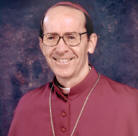Beauty is a door that leads to God. It has the power to open one’s heart to the Lord and to prepare it for the gift of faith.
Cardinal Danneels of Brussels, speaking of beauty’s role in evangelization, said:
One can find God through the door of truth, for truth attracts us. But many of our contemporaries are little Pointius Pilates who ask: ‘What is truth?” and remain outside the door without entering. God as Moral Perfection and Holiness also attracts us. But many will say: ‘Moral perfection attracts me, but I’m incapable of it,’ and they remain outside that door marked by their moral weaknesses. But beauty disarms: it is irresistible for contemporary men and women… The Church has so many beautiful things to say and to show to the world, not only in its artistic heritage, but also in so many saints who shone with beauty.”
A disarming beauty shines forth in this Chapel dedicated to Our Lady. It beckons us to enters its doors and to encounter the living Jesus Christ in the presence of His Blessed Mother, the most beautiful of all the saints.
In today’s Readings, the Lord speaks to us through beauty. Through the Prophet Isaiah, He employs the image of a delicious banquet to stir up the hope of Israel in the coming of the Messiah. He promises “on a mountain” to provide a “feast of rich food and choice wines”; He promises to “destroy death forever”; to “remove the reproach of His people” and “to wipe away tears from all faces.” The beauty of what God promises moves the hearts of his people. It is even strong enough to conquer the feast of death and restore the light of hope.
In the Gospel, Jesus goes “up a mountain” where He fulfills the prophecy recorded by Isaiah. First, He restores beauty to the human body. “Great crowds came to Him, having with them the lame, the blind, the deformed, the mute and many others. They placed them at His feet, and He cured them.”
We are told that “the crowds were amazed when they saw” this beauty, i.e. “the lame walking, the deformed made whole, the lame walking, and the blind able to see.” Christ who was at work in creating human persons from the beginning, with a beauty that reflects His own image, was at work “on this mountain” re-creating them, restoring their bodies to their original beauty, reawakening them to the wonder of being created in the image of God.
Then, He goes even further, revealing an even more profound beauty, one that goes beyond what the eyes of the body can see, or our ears can hear. He reveals the fire of love that resides deep within Him as He says: “My heart is moved with pity for the crowd, for they have been with me now for three days and have nothing to eat.”
Cardinal John Henry Newman, beatified by Pope Benedict XVI a year ago in England, chose as a motto for his life, a phrase that He considered the essence of Christianity: “Cor ad cor loquitur.” This is what was happening on the mountain in Galilee when Jesus cured those who were deformed and lame and fed the immense crowd with 7 loaves and a few fish. His sacred heart and their longing hearts were in beautiful harmony.
The crowd had been with Jesus on the mountain “for three days.” They were so spellbound by His teaching, so taken by His compassion and His mercy that they had lost track of time. It is not the crowd who notice that there is nothing for them to eat. It is Jesus who notices their hunger.
Without a doubt, He noticed more than the hunger of their bodies, and what He provided was far more than bodily food. Jesus, being the fullness of Beauty, gave what went beyond bodily needs. That is why the Church, throughout her history, has seen in Jesus’ feeding of the multitude on the mountain a beautiful image of the Messianic banquet, and the Eucharistic feast.
Because Jesus’ Heart is moved with pity for the hungry, He gave us His own Body and Blood in the Eucharist. Whoever hungers for holiness finds in Him the food that lasts forever and the beauty that enlightens the heart.
Beauty has within it the weight of glory. The Cross of Christ, for good reason, is the focal point of this beautiful chapel. It is called the Tree of Life; for the sacrifice that Jesus offered there conquered sin and death. At the foot of the Cross, His blessed Mother stood in prayerful vigil. In her, we see amazing strength and wondrous beauty. Is this not why we are so taken by the beauty of Michelangelo’s Pieta? That wonderful piece of art expresses the love that was stronger than death, and the hope that was wiser than despair. Never was Mary’s faith more keenly put to the test than that moment when she held her beloved son in her arms. Yet, her youthful face and her open left hand speak volumes about trust in God. Our world stands in dire need of such trust, such hope and strong beauty.
Blessed Mother Teresa of Calcutta said that her goal in life was to do something beautiful for God.
The mission of Legatus is “to study, live and spread the faith in your business, professional and personal lives.” When you do that, it will be beautiful in God’s eyes.

